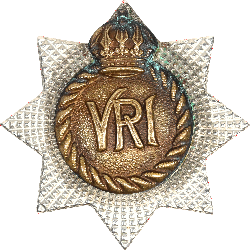Topic: The RCR
 In an appendix to the War Diary of The Royal Canadian Regiment for August 1916, Lieutenant Frank Dickson, in writing Notes on the History of the Regiment, stated:
In an appendix to the War Diary of The Royal Canadian Regiment for August 1916, Lieutenant Frank Dickson, in writing Notes on the History of the Regiment, stated: Our buttons and cap badge have V.R.I. on them. These letters stand for Victoria Regina Imperatrix which being translated, means, Victoria Queen and Empress (of India). Now this distinctive mark was given to us by the late Queen Victoria which is one of the facts of which we are most proud. The Militia Department of Canada have always tried to take it away from us, but, in spite of all, we have retained it and we all sincerely trust that we shall continue to do so.
After the death of Queen Victoria in 1901 until the coronation of Queen Elizabeth II in 1953, the British throne was occupied by Kings. Each time the sovereign changes, it is tradition that "Royal" regiments which wear the Royal cypher as a regimental emblem, whether on buttons or badges, change their accoutrements as each new sovereign chooses the stylized crown and cyphered initials to represent their reign.
 During the reign of King George V, and that of King Edward VII before him, The Royal Canadian Regiment, having been granted the privilege of wearing the Royal Cypher by Queen Victoria's, or a version of it [link Crowns Cyphers etc], resisted the change to the cyphers of the new sovereigns. For 18 years, except for a period of cease-fire in the staffing endeavours during the Great War, The RCR sought influence and approval to retain the Victorian designs. From 1901 to 1919, although the official regimental badges were those with cyphers of Edward VII and George V, The Royal Canadian Regiment continued to wear the Victorian cyphered badges as well as see the "King's badges" produced and distributed by the Militia Department.
During the reign of King George V, and that of King Edward VII before him, The Royal Canadian Regiment, having been granted the privilege of wearing the Royal Cypher by Queen Victoria's, or a version of it [link Crowns Cyphers etc], resisted the change to the cyphers of the new sovereigns. For 18 years, except for a period of cease-fire in the staffing endeavours during the Great War, The RCR sought influence and approval to retain the Victorian designs. From 1901 to 1919, although the official regimental badges were those with cyphers of Edward VII and George V, The Royal Canadian Regiment continued to wear the Victorian cyphered badges as well as see the "King's badges" produced and distributed by the Militia Department.
Photos of officers of The Royal Canadian Regiment wearing "VRI" badges during the First World War can be found, but less common is clear evidence that soldiers of the Regiment claimed and wore the same badges as their own. We do know that every soldier was instructed in the Regiment's preference for the Victorian badges, as shown above and in a 1917 regimental history pamphlet penned by Major Harry Cock:
In 1892 the name of the Regiment was changed, to the Canadian Regiment of Infantry, and the following year, on the occasion of Her Majesty's Birthday, the Queen approved of the Regiment becoming a Royal Regiment, known as the "Royal Regiment of Canadian Infantry," and granted permission for Her Imperial cypher, V.R.I. (Victoria Regina Imperatrix), with the Imperial crown, to be worn as a badge.
The photos above show a unique example of a soldier's "VRI" badge. This badge was worn by 427443 Pte Sidney Pearson Leach. We know it was his badge because, in order to mark it as his own, he scratched his service number onto the back of he badge.
 Sidney Pearson Leach
Sidney Pearson Leach
Sidney Leach was a 43-year-old printer from Weyburn, Saskatchewan, when he enlisted with the Canadian Expeditionary Force on 4 January 1915. An immigrant born in Manchester, England, Leach reported no prior service on his Attestation Paper. Leach enlisted with the 53rd Canadian Infantry Battalion, this unit was disbanded after arriving in England and its soldiers absorbed into the CEF's reinforcement system.
On 8 Jun 1816, the day that Sidney Leach was take on the strength of The RCR, the Regiment absorbed 199 new soldiers that day. 81 of these men, like Leach, were from the "Infantry Pool," although only three had original 53rd battalion service numbers. The other soldiers joining that date were taken in from the 45th, 59th and 61st Reserve battalions (33, 44 and 41 men, respectively, from each unit).
Sidney Leach's war with The Royal Canadian Regiment would not be an overly long one. By 15 November, five months after arriving, he would be reported as evacuated to England (Sick) aboard the Hospital Ship Dieppe. he would not return to The RCR in France.
Having survived the war, Leach would die on 9 August 1954. He is buried in Mountain View Cemetery, Vancouver, BC.
Leach's badge is an interesting and intriguing connection to his service on the battlefields of the Great War. Interestingly, as a reinforcement to The RCR, Learson would not have acquired the badge at one of the regimental stations as a long service soldier may have. Instead, he must have acquired the badge, as well as an understanding of its preference within the Regiment, during his own service overseas.

